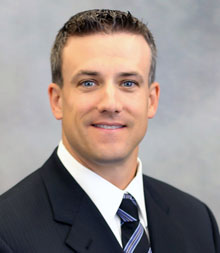
Message from your doctor…
Whether you or one of your family members or friends is considering total shoulder replacement, or are scheduled for surgery, I understand this can be a stressful time. And you may have forgotten some of the information we discussed during our last visit, or forgot to ask me a specific question about what to expect. This site is designed to help us stay connected, and to answer some of the most common questions patients ask me about shoulder replacement.
I want to make sure that both you and your family members have timely information at your fingertips during the days, weeks, and months following your surgery…so you can get back to enjoying the activities you love.
MOST COMMON QUESTIONS
Total Shoulder Replacement
How long do I need to wear my sling?
The sling should be worn at all times when you are up and walking around. A few times/day, while you are sitting and resting, you may remove the sling as long as your upper arm/shoulder stays near your body. You may take off the entire sling up to 3 times daily to bend and straighten your elbow while keeping your shoulder near your body. Most patients will require the sling for 4-6 weeks total.
What motions should I avoid?
Do not lift shoulder out in front of body, out to your side, or reach behind your back until your physical therapist has progressed you to that point in therapy. Usually, it is 4-6 weeks before you’ll be moving the shoulder on your own. It is ok to bend/straighten your elbow and use your hand to do things like typing (as long as your shoulder stays near your body). For example, you should put a computer keyboard in your lap instead of reaching out on a table for your keyboard). Initially in therapy, your therapist will do “passive motions,” which means your muscles won’t be doing the work. This protects your surgical repair and allows your body to heal.
Do NOT attempt to reach behind your back for about 3 months after surgery. This could put your shoulder at risk for dislocation. Wait until your physical therapist has progressed you to this motion.
When can I drive?
Please do not attempt driving for at least 4 weeks after surgery. This is for your safety, as well as other drivers- please do not attempt to drive with only one hand. Reasons for no driving post operatively: A quick, reactive motion of the shoulder while driving could damage your surgical repair. Secondly, you should not drive while taking any narcotic pain medications.
Antibiotics after joint replacements
Current guidelines suggest that for your lifetime, you should take antibiotics prior to routine dental cleanings/hygiene, fillings, and more invasive dental procedures.
We recommend the use of antibiotics prior to these procedures because during each of these procedures, a small amount of bleeding can occur which may allow bacteria to “seed” or spread through the bloodstream and can potentially travel to the replaced shoulder joint (or any area of the body where there is hardware from a surgery). This can be dangerous if an infection were to start in the replaced joint. To prevent this from happening, we recommend you take antibiotics ½ hour prior to dental procedures.
If possible, for safety reasons, we recommend waiting at least 3 months after a joint replacement to have any routine dental work completed.
If you have upcoming dental work, please call our office at least 3 days in advance, so we can send the appropriate antibiotic to your pharmacy.
SPORTS SPECIFICS
We know you are eager to return to your sports and hobbies. We want to guide you safely through that process. Please use the following as a guide.
GOLF
6 weeks post-op: Putting
3 months post-op: Chipping, pitching, and half-swings with your short irons
4-5 months post-op: Full but gentle swings with irons
6 months post-op: Full play with no restrictions
SWIMMING
3 weeks post-op: You may get in a pool at as long as your incision is well healed. You may do lower-body exercise/water walking. You should wait to swim until you have full and comfortable shoulder motion.
4-6 months: For most patients, you will be able to do full strokes
WEIGHT LIFTING
2-3 weeks post op: You may do lower body exercise (bike, walking, elliptical) with your sling on.
Please follow the instructions of your physical therapist for your shoulder. Once you are nearing the end of physical therapy (typically 3 months post-op), your therapist can create a safe “return-to-lifting” program. Physical Therapists and Athletic Trainers can outline a specific plan for you.



